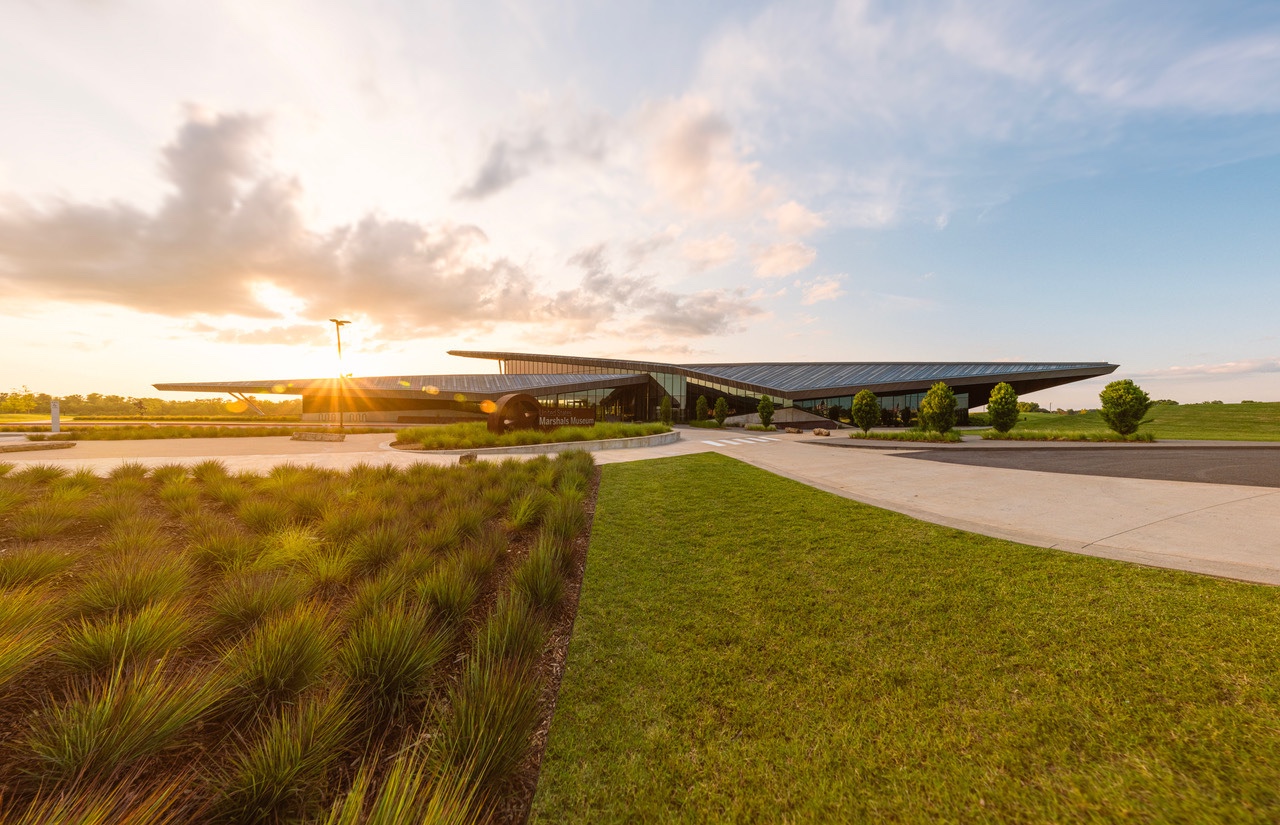The U.S. Marshals Museum, a world-class, national museum located on the banks of the beautiful Arkansas River in Fort Smith, Arkansas, opened its doors to visitors on July 1, 2023.
The U.S. Marshals Service is the oldest American federal law enforcement agency, created in 1789 by President George Washington. Since then, U.S. Marshals have worked on a daily basis to safeguard the nation’s streets and federal courts.
The history of the U.S. Marshals Service not only tells the story of law enforcement but also brings to light Americana, the Constitution of the United States, Bill of Rights, civil liberties, and patriotism. It tells the story of our nation since the marshal’s service and the country started at the same time. 
Sunset at the U.S. Marshals Museum in Fort Smith
The 53,000-square-foot museum features a unique exterior with a modified star-shaped design signifying the star badge worn by courageous U.S. Marshals. Inside, five immersive galleries educate guests about the critical, ever-evolving role the Marshals have played in upholding the Rule of Law, driven by justice, integrity and service. Galleries include: To Be A Marshal, The Campfire | Stories Under The Stars, Frontier Marshals, A Changing Nation and Modern Marshals.
The museum’s National Learning Center combines the museum experience with educational programming focused on the Constitution, the Rule of Law and civic literacy. It engages local and national audiences using a variety of resources.
The museum also honors the sacrifice of Marshals killed in the line of duty, as well as those who continue to place their lives in harm’s way, as they enforce the Constitution. Guests can pay tribute to the more than 350 Marshals killed in the line of duty since 1789 by visiting the Samuel M. Sicard Hall of Honor. 
Seal of the U.S. Marshals inside the museum gallery.
The museum adds an incredible element to an already vibrant Wild West history that is the hallmark of the city. Fort Smith is home to the National Historic Site, which chronicles the first fort built at Belle Point, the place where federal Marshals rode out of the United States and into Indian Territory, and where outlaws collides with Hanging Judge Isaac Parker. Fort Smith pays homage to U.S. Deputy Marshall Bass Reeves with an impressive 25-foot-statue and has many sites commemorating and preserving the Trail of Tears, Civil War and Butterfield Overland Mail Company route history that are now part of the Arkansas Heritage Trails System.
This colorful American background is the reason True West magazine selected Fort Smith as the Top True Western Town in 2013. The city has remained in the top ten each year since then.
The Campfire | Stories Under The Stars exhibit at the U.S. Marshals Museum.
Fort Smith is woven into the fabric of history, making it an ideal location for the museum to be built.
In 2007 after a rigorous selection process, the United States Marshals Service chose Fort Smith as the permanent home for its national museum. Since then, a diverse group of volunteers, staff, community leaders, and elected representatives from throughout Arkansas and across the nation have worked alongside the USMS to build this world-class facility.
“To say we’re excited would be a vast understatement,” said Doug Babb, Chair, USMM Board. “It’s truly gratifying to see the work of so many different people who have dedicated their time and resources to this effort come to fruition. This will be a jewel for Fort Smith, the state of Arkansas and the country.”
“I’m so excited to have the chance to lead this amazing group of people who have worked so diligently to reach this point,” said Benjamin Johnson, USMM President and CEO. “The Museum will inspire Americans across the country—both now and for future generations—to live with the core values of the U.S. Marshals Service; justice, integrity, and service. Now it’s time to welcome the world through our doors.”
Located on the Arkansas-Oklahoma border and near the junction of Interstates 40 and 49, Fort Smith is five miles from Van Buren, 47 miles from Arkansas wine country and 63 miles from Fayetteville.
For more information, visit usmmuseum.org.
